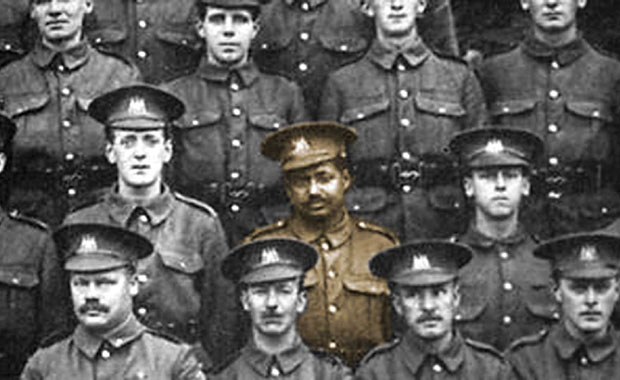Jon Sen: A blood-stained story
A pair of broken and blood-stained glasses tucked away inside a museum in West Bengal serves as a poignant reminder to the horrors of war and helped frame the incredible story of Mr Jogendra Nath Sen, the only non-white who fought in the 15th West Yorkshire Regiment and the first known Bengali to be killed in World War I. Discovered by London-based India-born Mr Santanu Das, an expert on India’s involvement in the war, the shattered pair of glasses and other memorabilia from the narrative of a documentary by Mr Shahid Hussain, just featured in the Inside Out segment on BBC One (Yorkshire).
Mr Sen hailed from Chandernagore (the former French Colony in Bengal now christened Chandannagar). He arrived in England in 1910 to study at Leeds University in West Yorkshire. When the war broke out, Mr Sen was employed as an assistant engineer at Leeds Corporation Electric Lighting Station. In September 1914, he was among the first to sign up for the 15th West Yorkshire Regiment, also known as the Leeds Pals Battalion. “It was in 2005 I discovered the broken and blood-stained glasses of Jogendra Sen in the French Institute in Chandernagore,” Mr Das said.
“In the Chandernagore display cabinet, the caption said that Jogendra Sen was part of the West Yorkshire Regiment, a citizen of Chandernagore and the first Bengali to be killed in the 1914-1918 war, on May 22, 1916,” Mr Das, a reader in English literature at London’s King’s College, said. Private Mr Sen was killed in action near the Somme in France, aged 28. His name is etched on the university’s war memorial, said Mr Das. Apart from the spectacles, the display cabinet proved to be a unique window to the past for Mr Das, who grew up in Kolkata. “There were other memorabilia related to Sen - a photograph of a European lady, a razor, a booklet, a dog-tag and a piece of string. The booklet, we now know, was ‘Poems about Friendship’ signed by an enigmatic young lady ‘Cis’ (Cicely),” Mr Das said, adding the objects inspired his book ‘1914-1918: Indians on the Western Front’.
With inputs and aid from local researchers and academics at the university, Mr Das was able to painstakingly piece together moments from Mr Sen’s short life. “He was the only Indian, non-white, in that battalion,” said Mr Das, who, however, couldn’t locate any descendant of Mr Sen. Around 70,000 Indian soldiers lost their lives in the war. Some 150,000 Indian soldiers were deployed in Europe from September 1914. Mr Sen’s story was unique because he went to war as part of a British and not an Indian battalion. Despite being one of the most well-educated men in the battalion, his attempts to join up as officer were prevented.
He was known as ‘Jon Sen’ or ‘John Sen’ by his army pals and was immensely respected by them, Mr Das informed. Mr Sen is buried in the Colincamps cemetery in northern France. The documentary ‘From Bombay to the Western Front: Indians in the First World War’ was launched in Britain on March 10, 2015 and is now available online.











Comments.